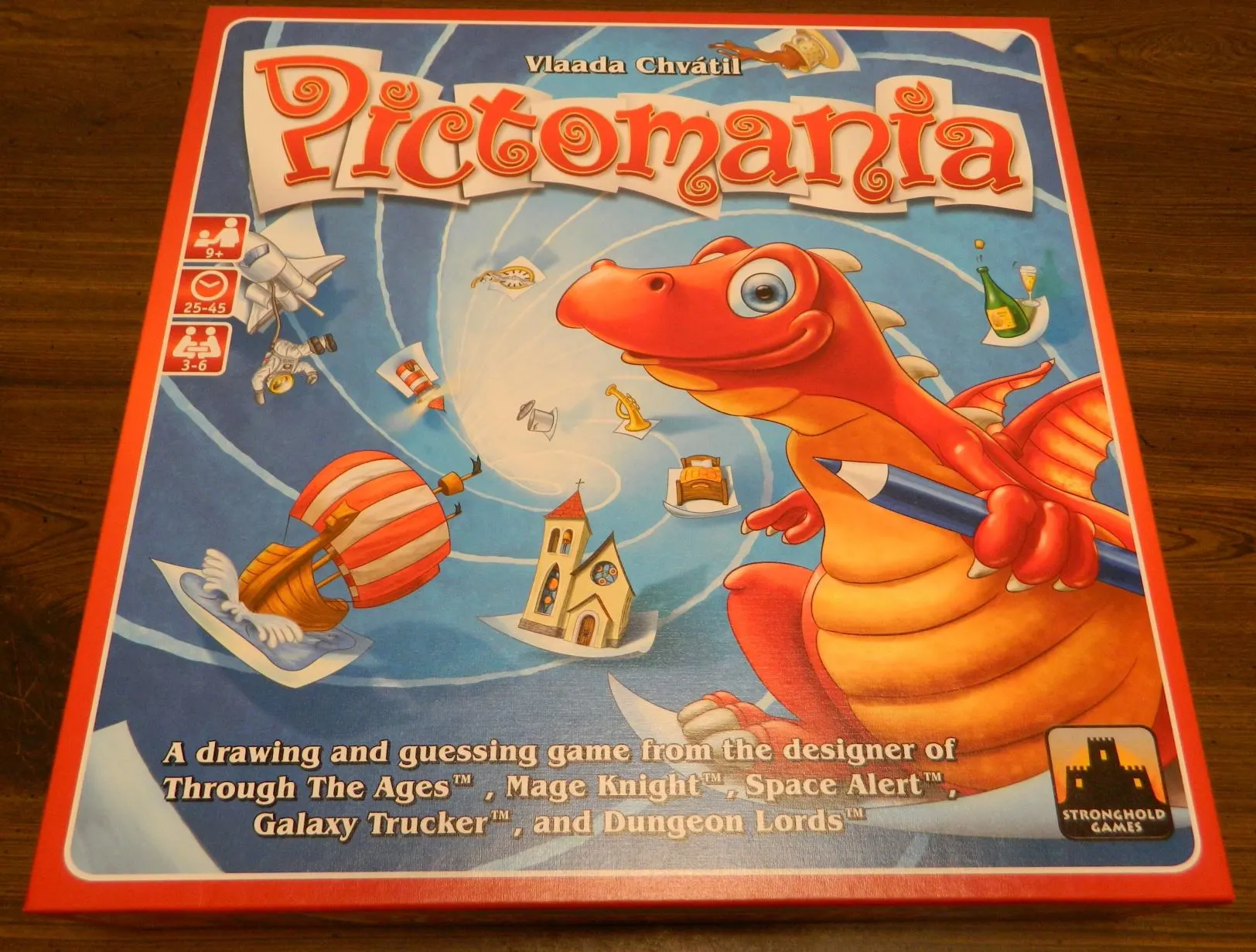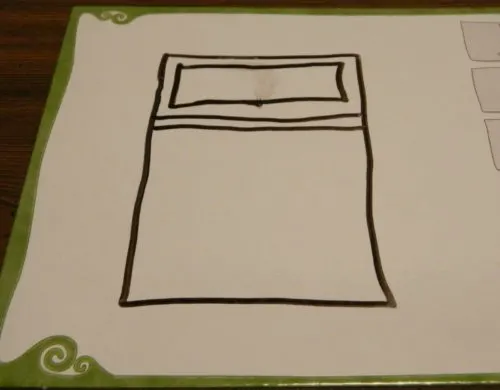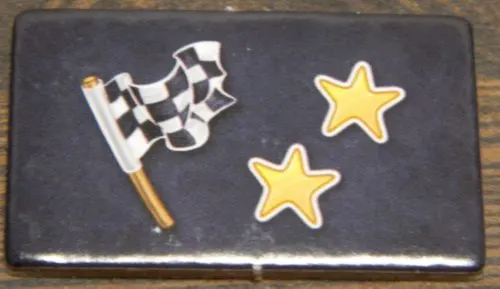The drawing board game genre is one of those that many people have strong feelings about. The genre is popular among a lot of people as Pictionary is arguably one of the most popular board games of all time. Many people hate the genre as well though for various reasons. I personally am somewhere in between as games from the genre can be fun. It isn’t one of my favorites genres though which is at least partially due to the fact that no one in my group is particularly good at drawing. As most drawing games are basically the same, I don’t usually give them much thought. When I say Pictomania though I was intrigued. The game is highly regarded as it was in the running for the Spiel Des Jahres back in 2012. What was even more interesting was the fact that it was designed by Vlaada Chvátil who has designed a ton of really popular board games including one of my favorites Codenames. With his reputation I was really curious how he would tweak the typical drawing game. Pictomania is a genuinely original take on your typical drawing game creating arguably the best drawing game that I have ever played.
How to Play Pictomania
As some of the rules have changed between the second and third editions of the game I will note the differences in the third edition in the corresponding sections below.
Setup
- Each player chooses a color and takes the sketch board, 7 guess cards and scoring tokens for that color. They will also take one dry-erase marker and an eraser. The scoring tokens that players will take depend on the number of players:
- 3 players: one 1 star and one 2 stars
- 4 players: two 1 star and one 2 stars
- 5 players: two 1 star, one 2 stars, and one 3 stars
- 6 players: three 1 star, one 2 stars, and one 3 stars
- Place the card racks so all of the players can easily see the cards that will be placed on them.
- The four decks of clue cards are placed on the table next to the number and symbol cards.
- A number of bonus point tokens will be placed on the table based on the number of players:
- 3 players: one 1 star, one 2 stars
- 4 players: one 1 star, two 2 stars
- 5 players: one 1 star, one 2 stars, two 3 stars
- 6 players: one 1 star, two 2 stars, two 3 stars
Playing the Game
Pictomania is played over five rounds. Each round consists of the following three phases.
Setup
Shuffle the number cards and symbol cards separately. Each player is dealt one card from each deck. Players should keep these cards facedown until the round is about to begin.
The players will choose the difficulty of clue cards that they would like to use. They will take six cards (three cards in the third edition) from the corresponding deck and place them on the card racks. The different difficulties in the game are as follows:
- Green – Easy
- Orange – Slightly Tricky
- Blue – Difficult
- Purple – Very Difficult
Each player should read through all of the clue cards to familiarize themselves with the words that could be used in the round. If a player doesn’t understand one of the words on one of the cards they can choose to replace the card with a new card. Each player can only do this once during the game. This shouldn’t be used to get rid of cards with words that players don’t want to draw.

These are the cards that will be used in the current round. Each player will be trying to draw a picture of one of the words on one of the cards.
Drawing and Guessing
Drawing
When everyone is ready the main part of each round begins. One of the players gives a start signal. All of the players can then look at the number and symbol card that they were dealt. The symbol card will tell you which clue card to look at. The number card will tell you the specific word/phrase on that card that you must draw. After looking at the word/phrase that you have to draw you will put the two cards face down next to your sketch board starting your guess pile.
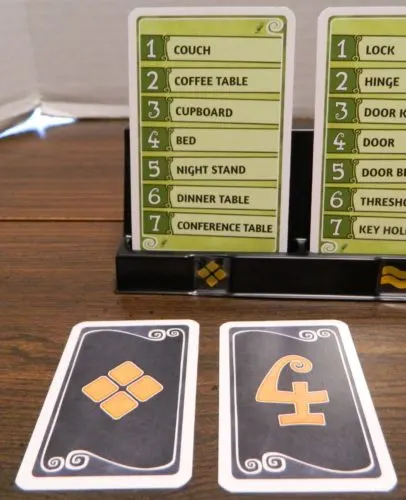
This player drew the four part diamond symbol and the four card. These two cards correspond to the word “bed” so this player will have to draw a bed.
When drawing you must follow these rules:
- Letters or numbers can never be used in your drawings. You can use scribbles to simulate letters/words though.
- You can erase part or all of your drawing. This cannot be used this to “animate” your drawing though.
- You can draw supporting elements to reinforce the word/phrase that you are trying to draw.
- Arrows can be used to emphasize parts of your drawing, illustrate a set of steps, or indicate a direction.
- You can cross off parts of your drawing to indicate that your word/phrase isn’t something.
- Mathematical symbols and other icons are allowed as long as they pertain to your word/phrase. You can’t use them to indicate the position of your word/phrase on a card.
- If you honestly can’t think of something to draw for your word/phrase you can choose not to draw anything. You can guess the other player’s drawings, but you can’t take a bonus point token.
- A player cannot make any comments, sounds, or gestures while drawing which will give players clues about what they are drawing.
- Your drawing can’t reference other items in the room such as using an arrow to point to something in the room.
- You cannot purposefully draw the wrong word/phrase.
When drawing if a player breaks any of these rules their drawing will be scored as if they drew the wrong word/phrase (see below).
Guessing
At the same time that people are drawing they can also start to make guesses at what they think the other players are drawing. Each player is given seven guess cards with each card featuring a different number. These numbers correspond to the seven rows on each clue card. When a player thinks that they know what another player is drawing they will place the corresponding number card on top of that player’s guess pile. You can make a guess at any time even if you aren’t done drawing your own picture. You may only play one guess card to each player’s guess pile though. Once you place a card in a guess pile you can’t replace it with a different guess card.
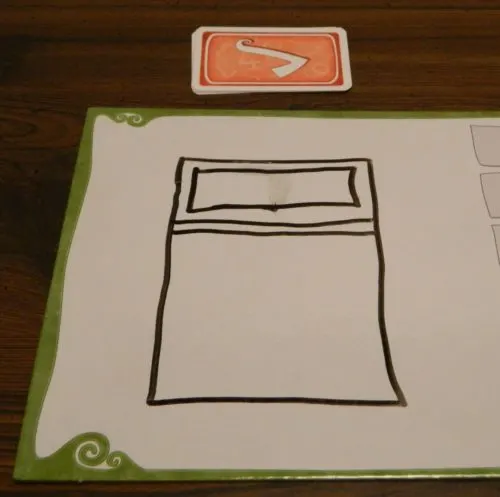
The red player thinks they know what this player was drawing so they have submitted their guess card.
In the third edition of the game you cannot continue drawing after you make your first guess.
Finishing the Phase
When a player is done guessing and drawing they can choose to take the bonus point token in the middle of the table that features the most stars. They will place the token on the table in front of them to indicate that they are done for the round. You can choose to take a bonus token before you have finished your drawing or guessed each player’s drawing. Once you take the bonus point token though you are not allowed to make any more guesses or add to your drawing. A player can also choose to end their participation in the phase without taking a bonus point token.
The phase will end when all of the bonus point tokens are taken or the remaining players choose not to take a bonus point token. When the last bonus point token is taken the phase ends immediately so the remaining player can’t make any more guesses.
Scoring
Players will then score points based on how well they drew and guessed the other player’s drawings. Choose one player to score their drawing first. The chosen player will flip over their guess pile making sure not to change the order of the cards that were played. The first two cards in the pile should be the player’s number and symbol cards which will reveal what the player was trying to draw.
At this point the player should verify that they were actually trying to draw the correct word/phrase. If a player obviously drew the wrong word/phrase the picture will be scored as if no player made a guess for the picture. All players will get their guess cards back and the player that drew the wrong thing will not reward any scoring tokens. If the player took a bonus scoring token they can’t score positive points for it, but they can lose points from it.
If the current player tried to draw the correct word/phrase they will then start looking at the guess cards submitted by the other players. They will begin with the card on top of the number and symbol cards (the first card submitted by another player). If the guess card was the correct number the current player will give them the highest valued scoring token of their color that they have remaining. The player will also be given back their guess card.
If a player played the wrong guess card the card will be placed in the middle of the table. This player will not receive a scoring token.
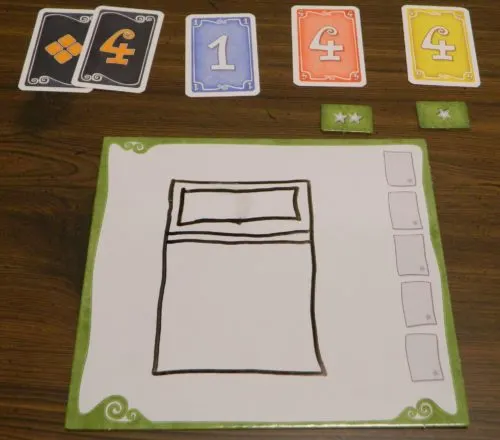
Three players submitted guesses for the green player’s picture. The blue player submitted a one which was wrong so they won’t receive a scoring token. Their guess card will remain in the middle of the table. The red player was the second to submit their guess card and they were right. They will receive the highest valued scoring token and their guess card will be returned to them. The yellow player also submitted the right guess card so they will receive the next highest scoring token.
After all of the guess cards have been handled the next player will score their drawing. This will continue until all of the players have scored their drawing. Players will then tally up the points they scored for the round. Players will score points as follows:
For each scoring token that a player has received from another player, they will score one point for each star pictured. For each of their own scoring tokens that they weren’t able to give to other players, they will lose one point for each star that is pictured.
Players will then score any bonus point tokens that were taken. Count up all of the guess cards in the middle of the table. The player who has the most guess cards in the middle of the table will lose one point for each star pictured on the bonus point token that they took. If two or more players tied for the most incorrect guesses (guess cards in the middle of the table), no players will lose points from their bonus point token. All of the other players will receive one point for each star pictured on the bonus point token they took as long as at least one player guessed their picture correctly. If none of the players correctly guessed the player’s picture though they will receive no points for their bonus point token.
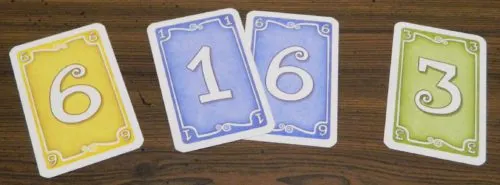
At the end of the round these cards were the incorrect guesses. As blue had the most incorrect guesses they will receive negative points from the bonus token that they took.
Each player will tally all of the points that they scored in the round and write down the total in one of the boxes along the edge of their sketch board.
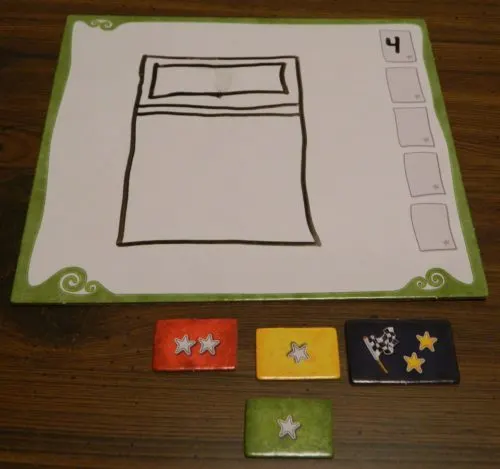
In this round the green player scored points as follows. They guessed both the red and yellow player’s pictures correctly so they received two points from the red picture and one from the yellow player. The green player took a two point bonus token as well. One of the players didn’t guess their picture correctly though so they lost one point for their remaining green scoring token.
Players will erase the drawing from their sketch board. If five rounds haven’t been played yet the next round is set up. All bonus point tokens are placed in the middle of the table. The number and symbol cards are taken back from the players. Each player takes back all of their scoring tokens and guess cards. To prepare for the next round follow the setup phase mentioned above.
End of Game
The game ends after the fifth round is played (fourth round in the third edition). Each player adds up all of the points they scored during the game. The player that scored the most points wins the game. If there is a tie the tied players share the victory.
My Thoughts on Pictomania
Before playing Pictomania I was really curious to see Vlaada Chvátil’s take on the drawing genre. The drawing game genre is not usually known for highly original premises as there is only so much you can do with a game that revolves around drawing things. Due to his reputation though I was confident that Pictomania would be a unique experience in the genre. The game maintains a lot of elements typical of the genre, but it also has some unique ideas that make it arguably the best drawing game that I have ever played.
Lets begin with what the game shares in common with other games from the genre. If you have ever played a drawing game before you will already be familiar with most of the game’s mechanics. Each player will be given a word/phrase that they are supposed to try and draw. They will try to draw them in a way that the other players will be able to successfully guess what they are trying to draw. This is to be expected as you can’t really have a drawing game without these mechanics. For this reason though your opinion on the drawing genre is likely going to have an impact on how much you like Pictomania. Pictomania is a good game, but it won’t be able to overcome a player’s distaste for the genre. If you typically hate drawing games I don’t see things being any different for Pictomania. If you love or can at least tolerate drawing games though there is a lot to like about the game.
Pictomania shares a lot in common with your typical drawing game, but it also differentiates itself in some unique new ways. I think the biggest difference in the game is the fact that all of the players play at the same time. In most drawing games one player draws while the rest of the players watch and try to guess what they are drawing. In Pictomania all of the players will draw and guess at the same time. While you are drawing you need to keep track of what the other players are drawing as you can make guesses at the same time. Some players may decide to finish their drawing before guessing while others may stop their drawing to make a quick guess at another player’s drawing before resuming their own drawing. To do well in the game you need to deal with guessing and drawing at the same time.
On the surface this might not seem like a huge change, but in action it does make Pictomania feel different than your typical drawing game. Instead of having players just sit watching another player draw, everyone will be doing it at the same time. This eliminates most of the downtime from the game outside of waiting after you have taken a bonus tile. This is one of the biggest problems many people have with traditional drawing games so it is a welcome change. Adding in a speed element where players have to handle two things at the same time keeps the game interesting as players feel more invested in what is going on.
This change also seems to put a much greater emphasis on guessing over drawing. Most drawing games rely mostly on your drawing skills. The player who is the best at drawing things usually has a pretty big advantage. Drawing is still very important in Pictomania as you are going to struggle if your drawing skills are terrible. In most drawing games a terrible drawer would have no chance at winning the game. The game places more emphasis on correctly guessing the other player’s drawings quickly though. You could struggle with drawing, but you can somewhat offset that by correctly guessing what the other players are trying to draw. In some ways guessing the other players’ drawings is just as important as drawing well yourself. The player that is best at guessing the other players’ drawings quickly can score a lot of points in the game. You could do a great job drawing, but if you ignore guessing the other players’ drawings you are going to struggle in the game.
The other thing that really differentiates Pictomania from most drawing games is that players aren’t just randomly guessing words. Six cards are placed out on the racks at the beginning of each round which show all of the possible words that players could draw. Each player will draw a number and symbol card which indicates what word that they will have to draw. This is an interesting twist on your typical drawing game as it adds a sort of deduction mechanic to the game. You don’t need to know exactly what a player is drawing. You just need to try to compare what they are drawing to the potential options listed on the cards. I thought this was a really clever idea.
What makes the mechanic even better is how the cards are designed. All of the words on a card are very similar. For example a card might feature types of furniture or fruit. You may even have two or more cards with similar themes out at the same time. This makes the game considerably more interesting for a couple reasons. First when drawing you need to analyze the cards closely as you have to accentuate specific elements of your drawing in order to distinguish it from other similar options. This makes guessing considerably more difficult as well. You could think you know exactly what another player is drawing and then spot another word that is basically the same. On top of this the words on the cards can be quite difficult as well. The cards are divided into different difficulties, but some of the cards for the easiest difficulties can still be quite hard. The hardest difficulties in particular seem really difficult to the point where I don’t know how you could even draw them well enough to get correct guesses unless you are a great artist.
The difficulty of the cards does add some luck to the game though. All of the cards in a particular difficulty level do not seem to be equal. There will be some words that are really easy to draw and others that will be really difficult. Obviously you hope to get one of the easy words as it will be much easier to draw and more players will correctly guess your drawing. On the other hand if you get one of the really difficult words you are going to have a hard time getting the other players to guess your word. This adds some unnecessary luck to the game as the difficulty of the words that you have to draw could make the difference between winning or losing the game.
The last thing that really differentiates Pictomania is how scoring is conducted in the game. In most drawing games you just get a point if another player correctly guesses your drawing. In Pictomania you score points for how well you guess and how well the other players guess your words. As for guessing the other player’s drawings you score points for how quickly you submit the right number for their word. The earliest player will score the most points and so on. Therefore you are rewarded for guessing quickly, but you don’t want to guess too quickly where you end up guessing wrong. For your own drawing you lose points for each player who doesn’t correctly guess your drawing. The combination of these two ways of scoring encourages players to draw well themselves while trying to guess the other players’ drawings quickly. I really liked the game’s scoring system as it does a good job rewarding players for doing well in both aspects of the game.
With all of these additional mechanics some may wonder how the game compares in difficulty to your typical drawing game. I would say that the game is a little more difficult than most drawing games. Most of this comes from understanding the scoring system. I would still say that the game is still pretty easy to learn though. I would guess you could teach the game to most players within around five minutes. It may be a little more difficult than most games from the genre, but I still think it should work well with children and adults that don’t typically play a lot of board games.
As for the components I would say that Pictomania does a good job. This review is based on the second edition of the game as the third edition is slightly different. The rules are mostly the same outside of a few tweaks mentioned in the rules section. Otherwise the third edition mostly uses paper instead of the dry erase boards and some other cheaper components due to having a cheaper retail price. The component quality for the second edition is quite good. The cards and cardboard pieces are pretty thick so they should last. The artwork is pretty good. I liked clue cards as the game includes 99 of them and each is double sided. I kind of wish more cards were included in the easier difficulties though as the hard difficulties are quite difficult. Otherwise I just wish there were more of them as I always prefer more cards for these type of games. The dry erase boards work pretty well, but the included erasers are pretty bad.
Should You Buy Pictomania?
Pictomania is in many ways what everyone should want out of a drawing game. The basic mechanics are the same as your traditional drawing game. Thus your opinion of drawing games in general are going to play a big role in your opinion of Pictomania. Vlaada Chvátil did a really good job adding his own little twists to the genre though. Instead of each player taking their turn drawing, all of the players will draw and guess at the same time. This might feel a little frantic at first, but it really works for the game. There is little downtime to the game as players have to juggle drawing and guessing at the same time. To do well in the game you need to succeed at both aspects. As all of the potential words are visible at all times, Pictomania kind of feels like a deduction game. The cards are designed in a way that there are many similar words so players need to draw and guess carefully as it is easy to make a mistake. The scoring may take a little while to fully grasp, but it does a good job rewarding players for both drawing and guessing well. Due to what words/phrases players are forced to draw though there is a decent amount of luck to the game as the difficulty between words/phrases can vary quite a bit. Pictomania in many ways shares a lot in common with your typical drawing game, but it is arguably the best drawing game that I have ever played.
My recommendation for Pictomania comes down to your opinion of drawing games in general. If you hate the genre there is no reason that Pictomania will change your mind. If you love or at least don’t mind drawing games though I think you will enjoy Pictomania and should consider picking it up.
Buy Pictomania online: Amazon (Second Edition, Third Edition
), eBay

